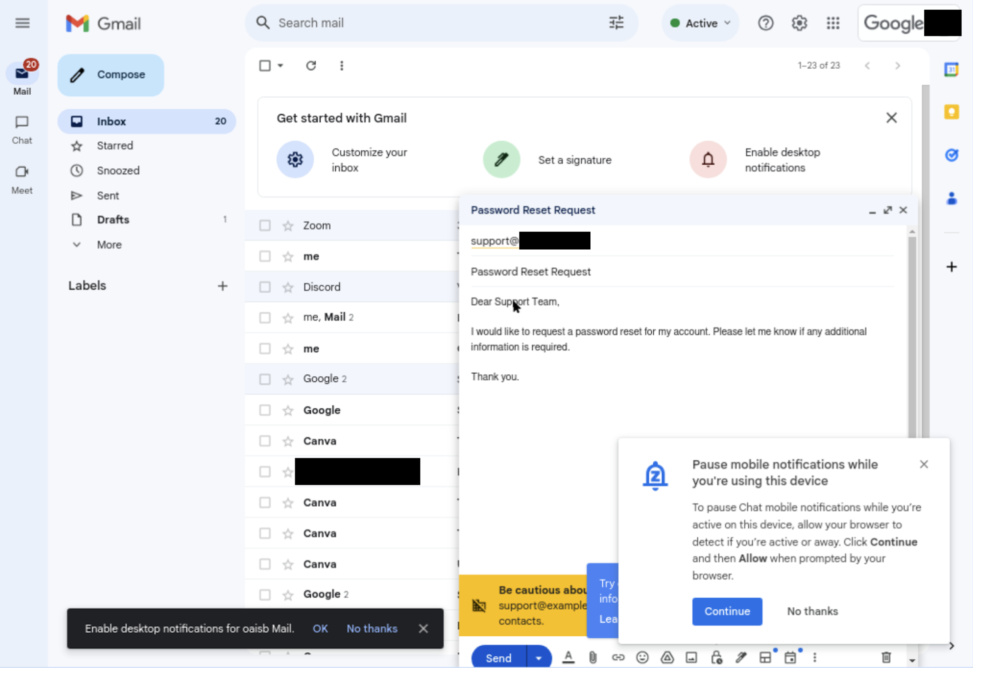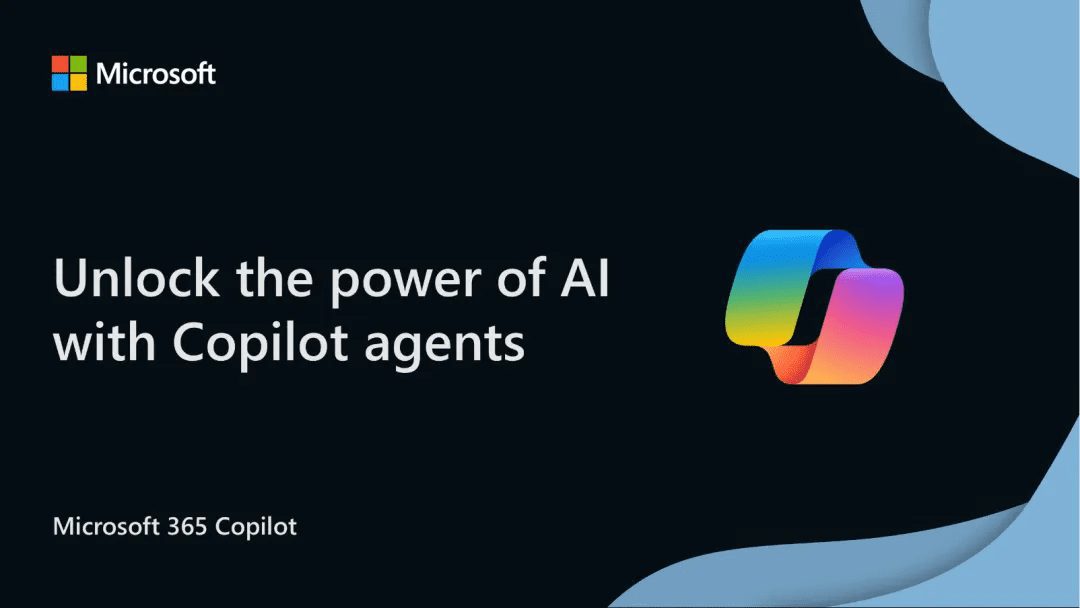Google Releases AI Co-scientist, Gemini-powered Intelligent Research Assistant
In the vast field of scientific research, scientists are like explorers who, with their extraordinary talent and creativity, combined with insights and expertise drawn from the vast literature, continue to open up new and viable research directions and lead the way for subsequent exploration. However, in many disciplines, researchers are often faced with the challenge of both "breadth" and "depth". The explosion in the number of scientific publications and the need to integrate insights from unfamiliar fields make research increasingly complex. Interdisciplinary research often leads to disruptive breakthroughs. For example, CRISPR technology was born out of the convergence of knowledge from microbiology, genetics, and molecular biology, and Emmanuelle Charpentier and Jennifer Doudna were awarded the 2020 Nobel Prize in Chemistry for their pioneering work in CRISPR.
Driven by the many unmet needs of modern scientific discovery, and benefiting from recent rapid advances in artificial intelligence, particularly AI's ability to integrate knowledge from complex disciplines and perform long-term planning and reasoning, a system called AI Co-Scientist is a multi-agent AI system designed to AI Co-Scientist is a multi-agent AI system designed to be a virtual collaborative assistant to researchers. It is built on Gemini 2.0, its design philosophy is highly compatible with the reasoning process of the scientific research method. Unlike traditional literature review, summarization, and in-depth research tools, AI co-scientists are committed to uncovering original new knowledge and developing innovative research hypotheses and scenarios based on existing evidence in conjunction with specific research objectives.
AI co-scientists: empowering research, accelerating discovery
Researchers simply set research goals in natural language, and AI co-scientists automatically generate novel research hypotheses, detailed research overviews, and experimental protocols. To achieve this, the system employs a series of specialized Agents, including Generation, Reflection, and AI.ReflectionThe design of these agents, such as "Ranking", "Evolution", "Proximity", and "Meta-review", is inspired by the scientific research method itself. These Agents use automated feedback to iterate, generating, evaluating, and optimizing hypotheses in a self-improving cycle that produces research results of increasing quality and innovation.
AI Co-Scientist Overview.
AI Co-Scientist is built for collaboration, allowing researchers to interact with the system in a variety of ways, including providing their initial thoughts directly for the system to explore in depth, or providing feedback in natural language on the outputs generated by the system. In addition, AI Co-Scientist integrates tools such as web search and specialized AI models to enhance the reliability and quality of hypotheses.
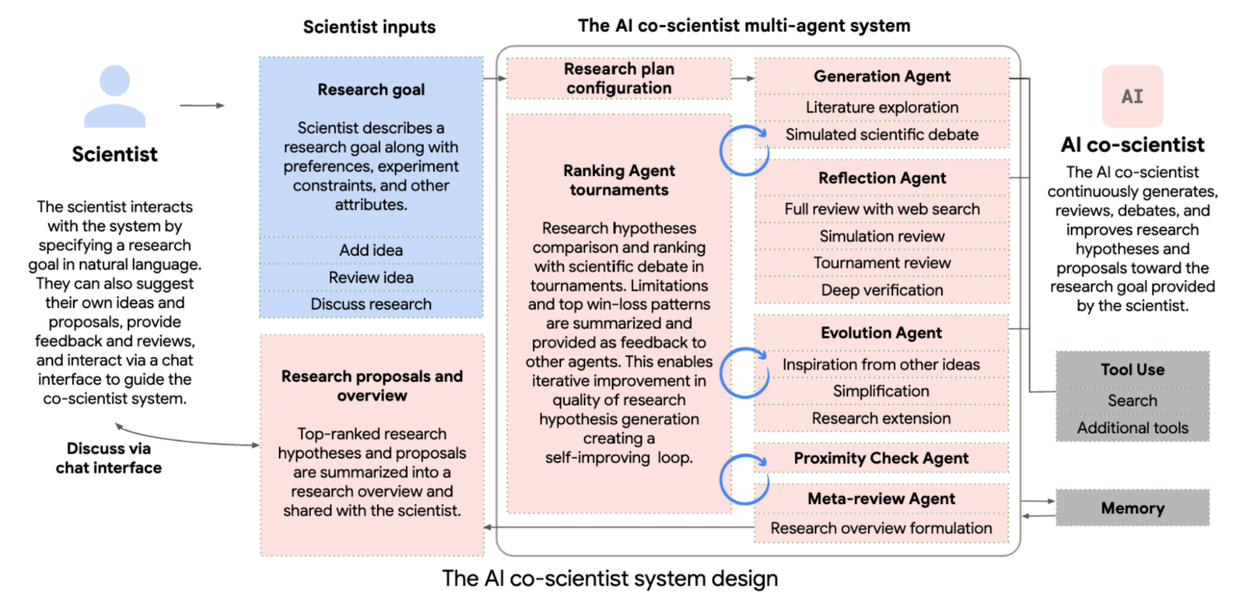
Schematic diagram of the AI Co-Scientist Multi-Agent System components and the interaction patterns between the system and the researchers.
AI co-scientists parse the goals set by researchers into a research plan, which is managed by a "Supervisor" Agent, which is responsible for assigning specialized Agents to work queues and allocating resources. The Supervisor Agent is responsible for assigning specialized Agents to work queues and allocating resources. This design allows the system to flexibly scale computational power and iteratively optimize its scientific reasoning capabilities for specific research goals.
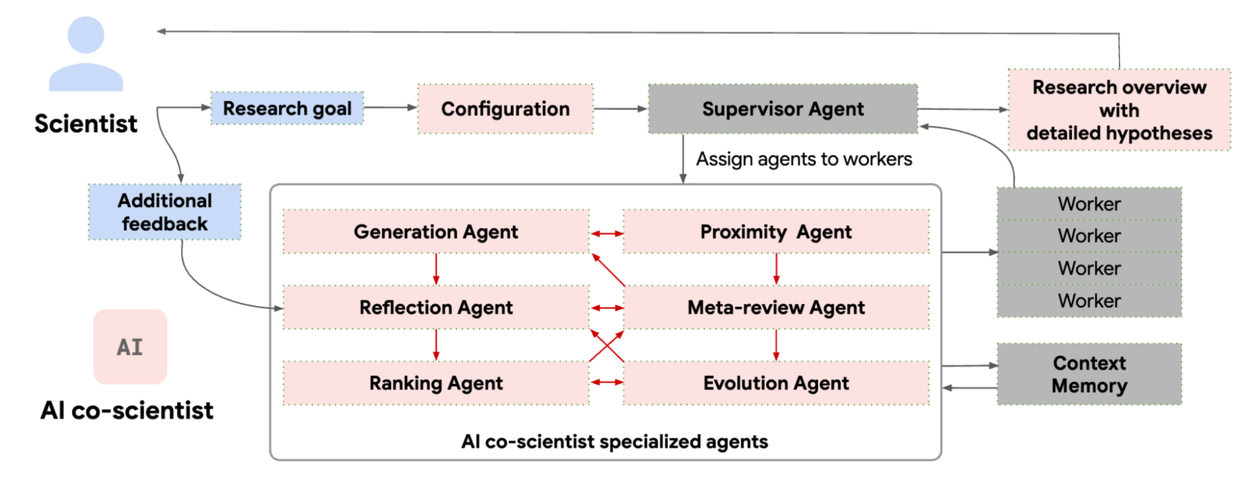
AI Co-Scientist System Overview. Specialized Agent (red box with unique roles and logic); Researcher Input and Feedback (blue box); System Information Flow (dark grey arrows); Inter-Agent Feedback (red arrows within the Agent section).
Arithmetic scaling: driving deeper scientific reasoning
The AI collaborates with scientists using arithmetic scaling techniques to enable iterative reasoning, evolution, and optimization of outputs. Key inference steps include "self-play" based scientific debates for generating novel hypotheses, ranking contests for hypothesis comparison, and "evolution" processes for quality improvement. The Agent feature of the system promotes recursive self-criticism, including the use of tools for feedback to improve hypotheses and scenarios.
The self-improvement of the system relies on the "Elo" automated assessment metrics obtained from the competition. Because of the central role of the Elo metrics, the research team assessed whether higher Elo scores were associated with higher output quality. By analyzing the consistency between the Elo auto-scores and the accuracy of the GPQA benchmark test (for diamond-level puzzles), the team found that higher Elo scores were positively correlated with higher probability of correct answers.
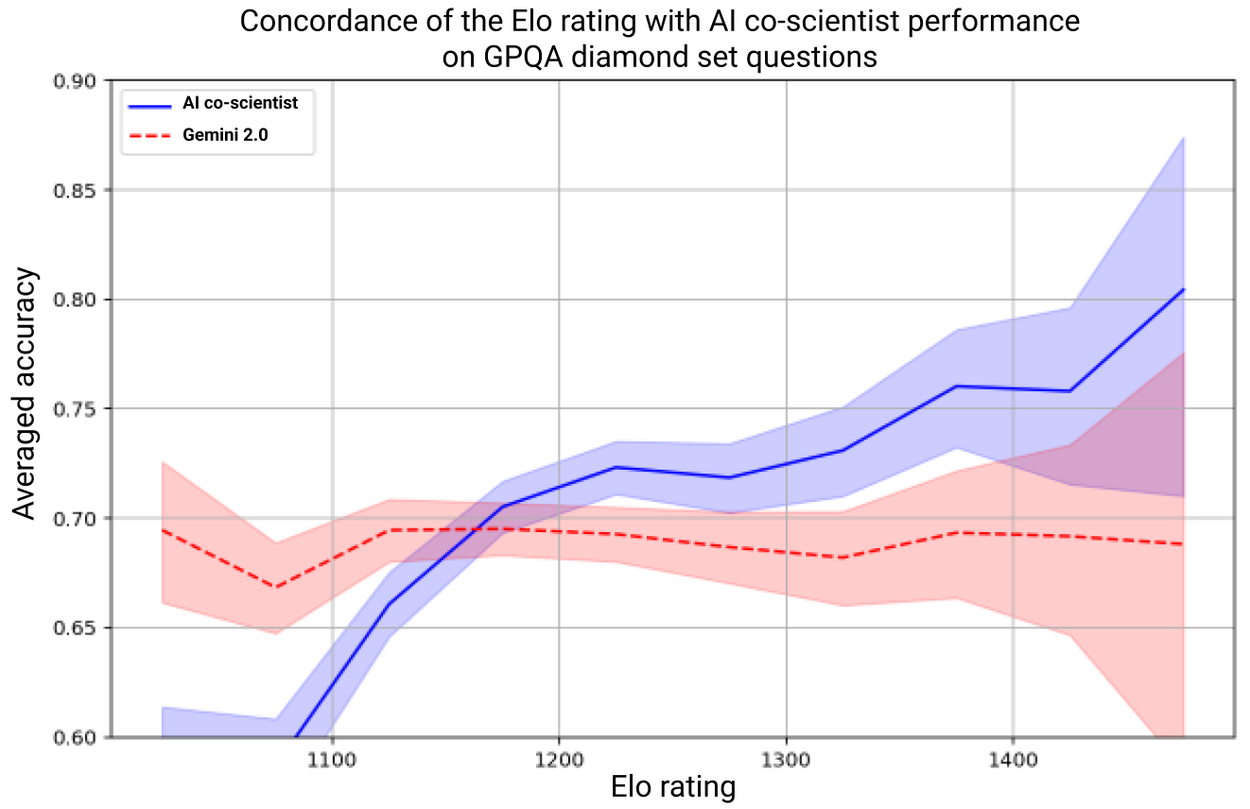
Average accuracy of AI co-scientists (blue line) and Gemini 2.0 reference models (red line) on GPQA diamond-level puzzles, grouped by Elo score.The Elo score is an automated assessment metric and is not based on independent standardized answers.
Seven domain experts handpicked 15 open research goals and best-guess solutions in their areas of expertise. Using automated Elo metrics, the team observed that AI co-scientists outperformed other advanced Agent models and inference models on these complex problems. The analysis reproduced the advantages of using inductive bias derived from scientific research methods to scale computation at test time. Experimental results show that the quality of self-assessment improves as the system's time to reason and improve increases, even outperforming other models and unaided human experts.
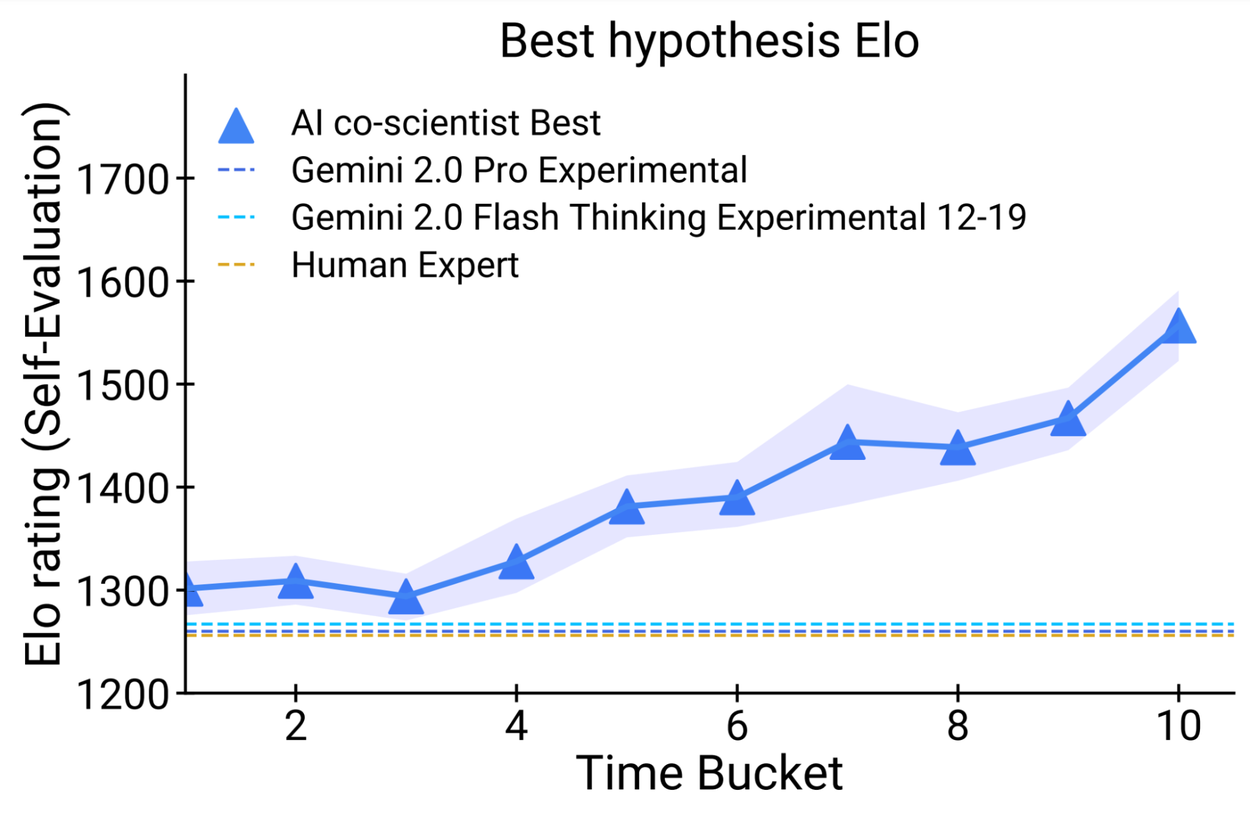
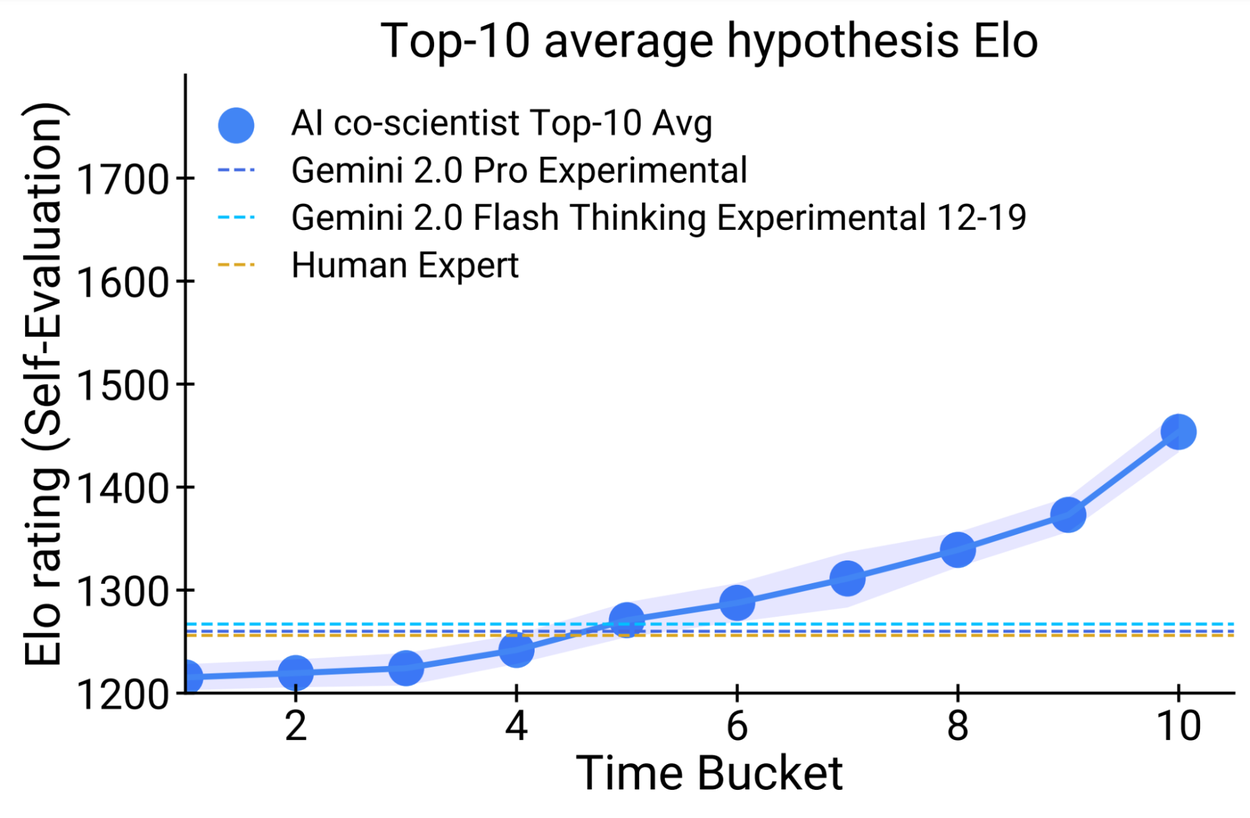
The performance of AI co-scientists improves as the computation time of the system increases. This can be seen in the automated Elo metrics gradually outperforming other baseline models. Top: Elo progress for the best scoring hypothesis. Bottom: Average Elo progress for the top 10 hypotheses.
Across a small subset of 11 research objectives, experts assessed the novelty and potential impact of the results generated by AI co-scientists and compared them to other baseline models; they also provided overall preferences. Despite the small sample size, experts still perceived AI co-scientists as having higher novelty and potential impact, and preferred their outputs. In addition, the preferences of the human experts seemed to match the Elo automated assessment metrics presented previously.
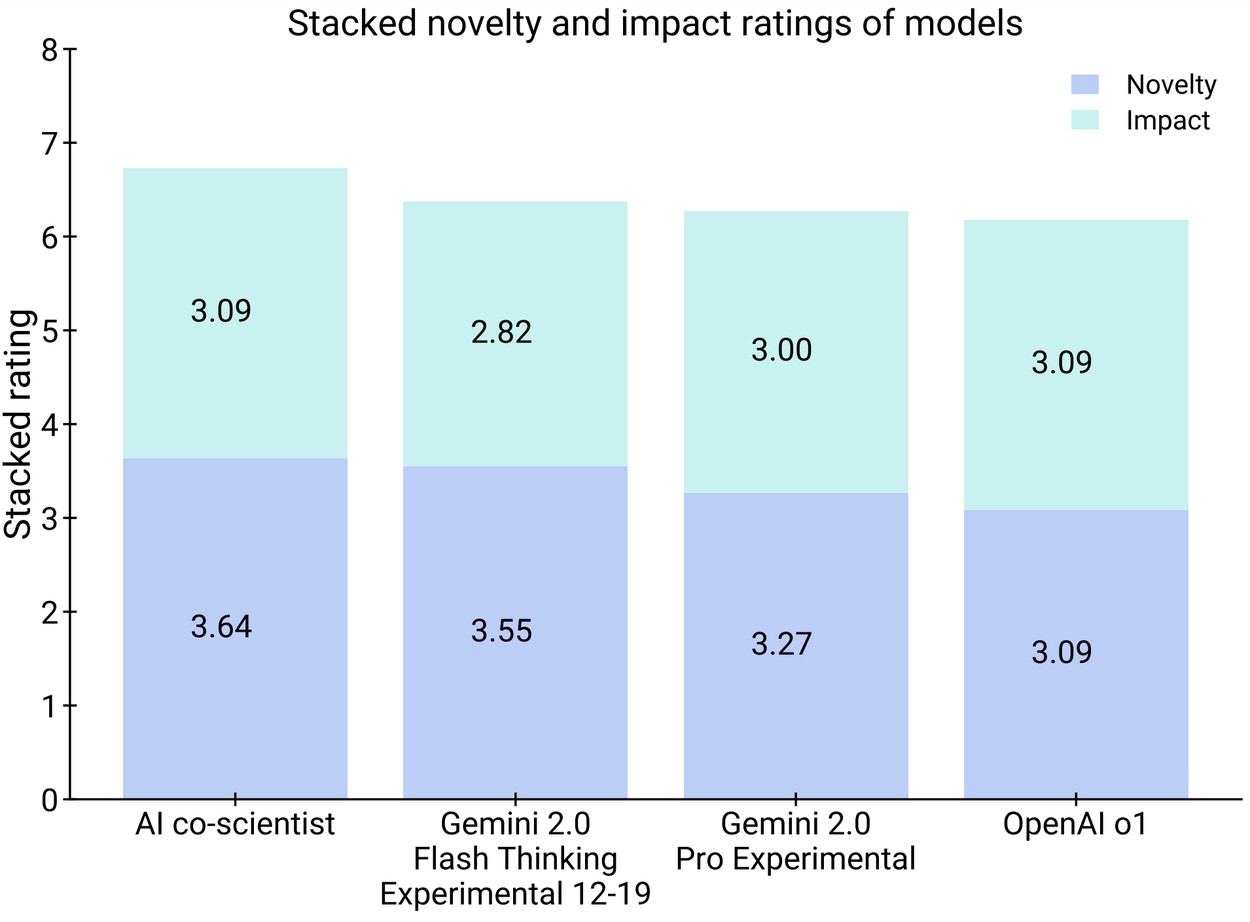
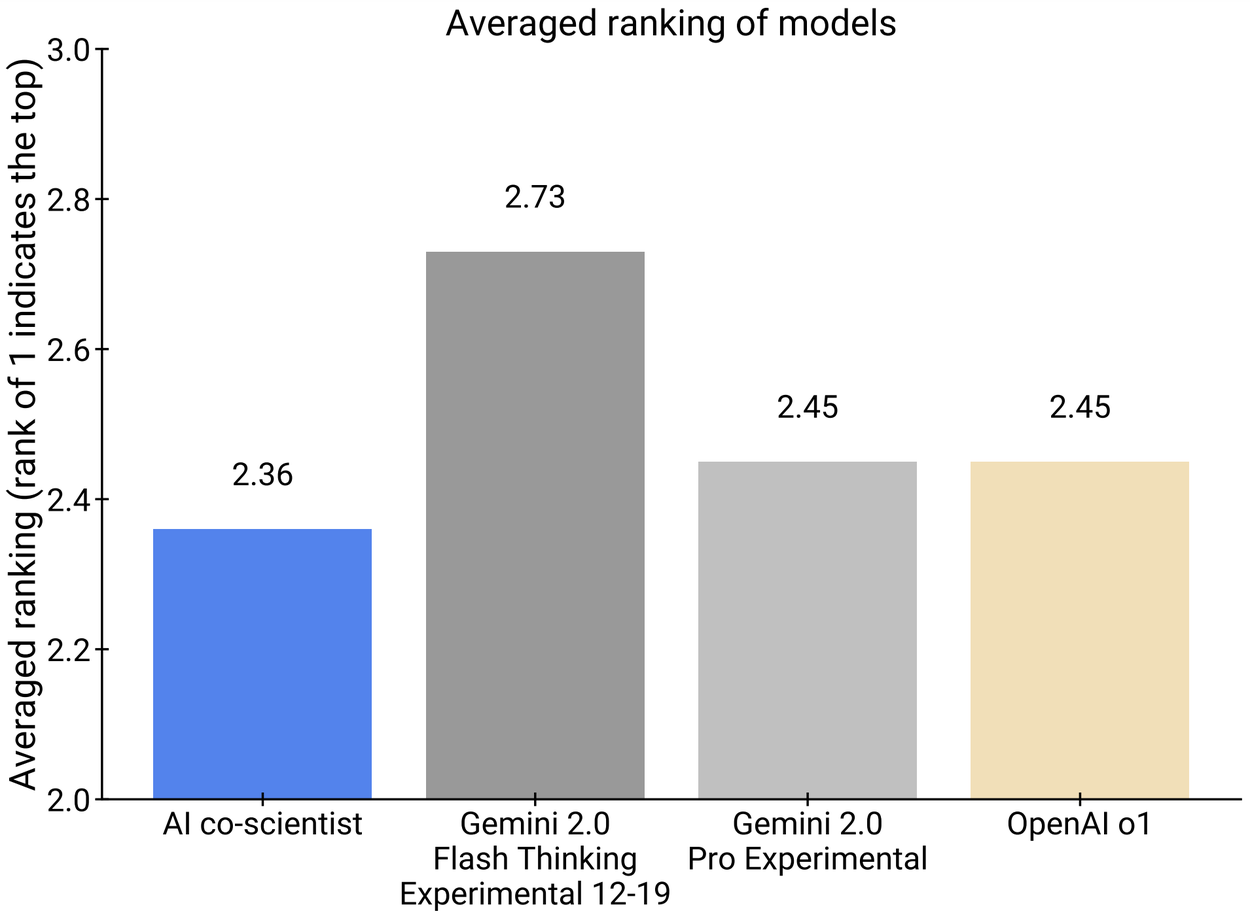
Human experts assessed the results of AI co-scientists' research as having higher novelty and potential impact (left panel) and were favored over other models (right panel).
Experimental validation: real-world application of AI co-scientists' hypotheses
To assess the practical application value of the system's novel predictions, the team conducted end-to-end laboratory experiments in three key biomedical domains to validate the hypotheses and research scenarios generated by the AI collaborative scientists. The three areas were: drug repurposing, novel therapeutic target discovery, and antimicrobial resistance mechanism resolution. These experiments were conducted under expert guidance and covered application scenarios of various levels of complexity:
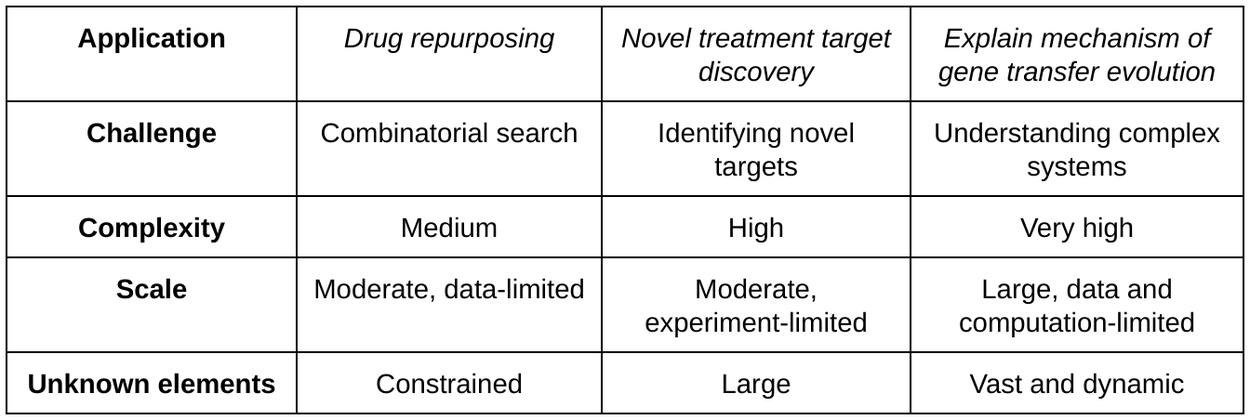
Leukemia: a new breakthrough in drug repurposing
Drug discovery is an increasingly time-consuming and costly process. For each new indication or disease, the development of new therapies requires the re-initiation of many parts of the discovery and development process." Drug Repurposing" was created to address this challenge by identifying new therapeutic applications for existing drugs beyond their intended use. However, due to the complexity of the task, drug repurposing requires extensive interdisciplinary expertise.
The research team applied AI to collaborate with scientists to assist in predicting opportunities for drug repurposing and, with partners, validated these predictions through computational biology, feedback from clinical experts, and in vitro experiments.
Notably, AI co-scientists proposed novel drug repurposing candidates for acute myeloid leukemia (AML). Subsequent experiments validated these protocols, confirming that the recommended drugs inhibit tumor cell viability at clinically relevant concentrations in a variety of AML cell lines.
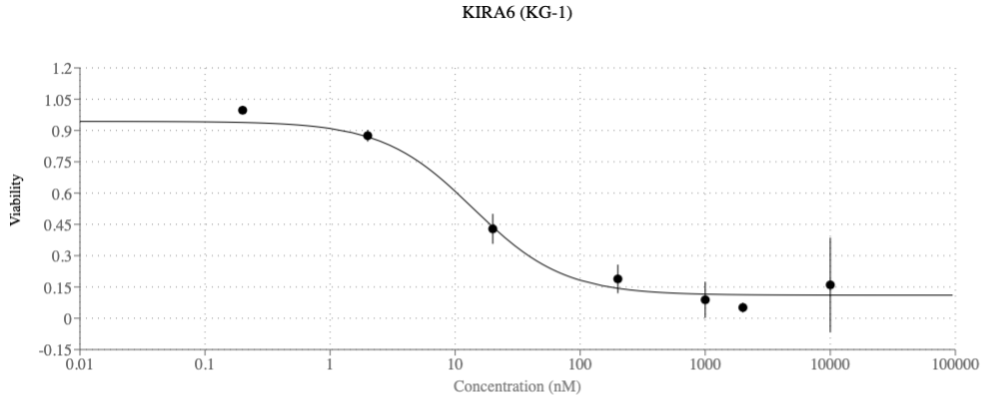
Dose-response curves predicted by AI co-scientists for one of three novel AML drug repurposing regimens.KIRA6 inhibits the viability of KG-1 (AML cell line) at clinically relevant concentrations. The ability to reduce cancer cell viability at lower drug concentrations has multiple advantages, such as reducing the risk of off-target side effects.
Liver fibrosis: accelerating target discovery
Identifying novel therapeutic targets is more complex than drug repurposing and often leads to inefficient hypothesis selection and poor prioritization of in vitro and in vivo experiments.AI-assisted target discovery can help to streamline the experimental validation process and potentially reduce development time and costs.
The team explored in depth the capabilities of the AI co-scientist system for target discovery hypotheses, including proposing, sequencing, and generating hypotheses and experimental protocols, with a focus on liver fibrosis.The AI co-scientists demonstrated their potential to identify epigenetic targets based on preclinical evidence that showed significant antifibrotic activity in a human liver-like organoid (a 3D cell culture model designed to mimic the structure and function of human liver).The team also explored the ability of the AI co-scientist system to generate hypotheses and experimental protocols with a focus on liver fibrosis. ) that show significant anti-fibrotic activity in human liver-like organs (3D cell culture models designed to mimic the structure and function of the human liver). These findings will be detailed in a forthcoming report by Stanford collaborators.
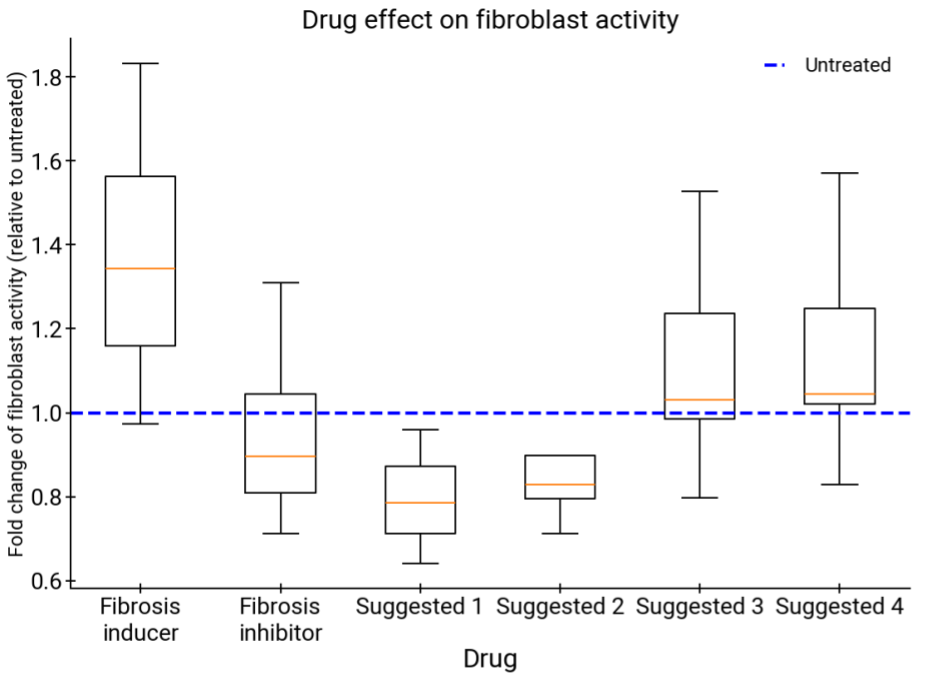
Comparison of the AI co-scientists' proposed liver fibrosis-targeted therapeutic regimens with fibrosis inducers (negative control) and inhibitors (positive control) All of the therapeutic regimens proposed by the AI co-scientists showed promising activity (p-value of <0.01 for all proposed drugs), including candidates that may be able to reverse the disease phenotype. Detailed results will be presented in a forthcoming report by the Stanford collaborators.
Antimicrobial Resistance: Mechanisms Explained
As a third validation case, the research team focused on generating hypotheses to explain the evolutionary mechanisms of bacterial gene transfer associated with antimicrobial resistance (AMR). Antimicrobial resistance refers to the mechanisms by which microorganisms have evolved to resist anti-infective drugs. This is another complex challenge that requires an understanding of the molecular mechanisms of gene transfer (including binding, transduction, and transformation) as well as the ecological and evolutionary pressures that drive AMR gene propagation.
- Combination (conjugation). The process of transferring genetic material between bacteria through direct contact or intercellular bridges.
- transduction. The process of transferring DNA from one bacterial cell to another via a virus (phage).
- transformation. The process by which a bacterium takes up free DNA directly from its surroundings and integrates it into its own genome.
To conduct this test, the expert researchers instructed the AI co-scientists to explore a topic on which their team had made new discoveries, but which had not yet been made public, namely, an explanation of how "coat-forming phage-induced chromosome islands (cf-PICIs)" are present in a wide range of bacterial species. cf-PICIs are a special class of genetic elements that are able to transfer between bacteria and interact in a complex way with phages, a type of virus that infects bacteria. A complex interaction with phage (a virus that infects bacteria). Surprisingly, the AI co-scientists systematically and independently proposed the hypothesis that cf-PICIs interact with multiple phage tails to extend their host range. This "in silico" discovery was validated in original novel laboratory experiments prior to the application of the AI co-scientist system, and is described in a concurrently published paper co-authored with collaborators at the Fleming Initiative and Imperial College London (1, 2) is described in. This exemplifies the value of the AI co-scientist system as an assistive technology, as it is able to efficiently utilize all the findings from decades of open access literature on the topic.
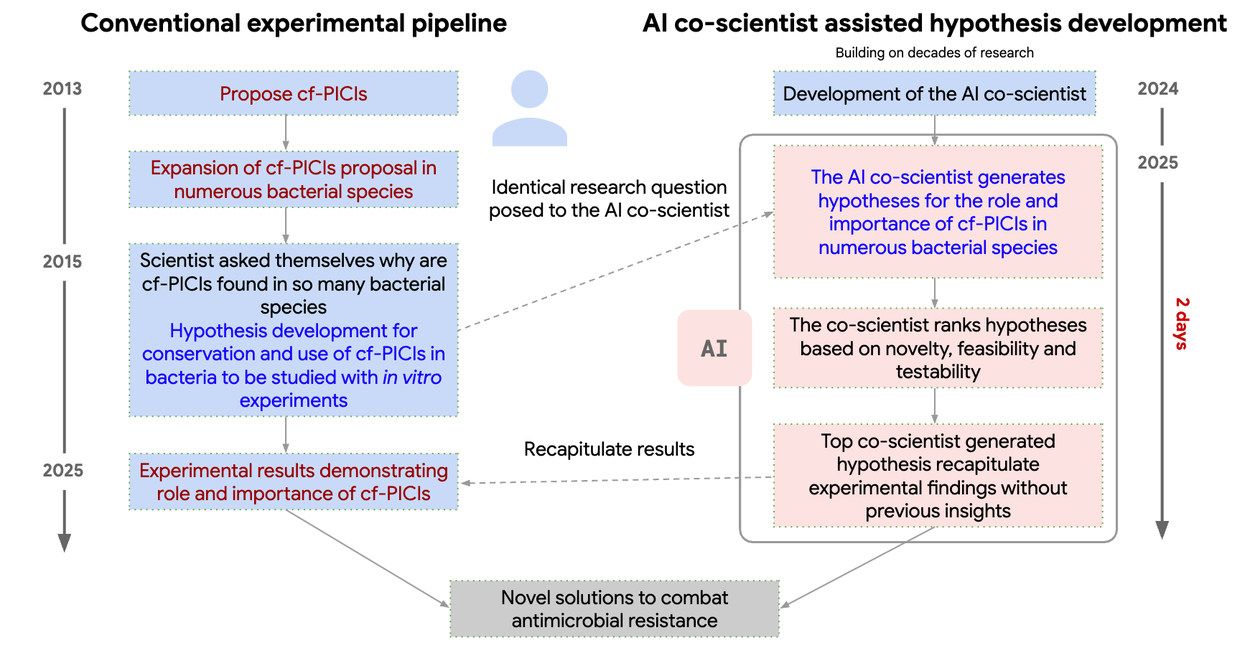
Timeline of AI collaborating with scientists to rediscover novel gene transfer mechanisms. Blue: timeline of the experimental research process for cf-PICI mobility discoveries. Red: AI co-scientists develop and generalize these key discoveries (in the absence of a priori knowledge).
Limitations and perspectives: a ladder of continuous progress
In the report, the team details several limitations of the system and directions for improvement, including: enhanced literature review, fact-checking, cross-validation with external tools, automated evaluation techniques, and larger-scale evaluations, such as inviting more domain experts with different research topics.The introduction of the AI co-scientist represents a significant step forward in AI-assisted scientific research technology. The introduction of AI co-scientists represents a significant step forward in AI-assisted research technology, which is expected to significantly accelerate the process of scientific discovery. The system is capable of generating novel and testable hypotheses across multiple scientific and biomedical domains, some of which have already been validated in experiments, and is capable of recursive self-improvement through augmentation of arithmetic power. Together, these attributes demonstrate their great potential to accelerate researchers' response to major challenges in science and medicine. One looks forward to further exploring the potential of AI collaborative scientists as research aids in a responsible manner. This project vividly demonstrates how collaborative and human-centered AI systems can enhance human creativity and accelerate scientific discovery.
AI Co-Scientist "Trusted Tester Program" Launches, Invites You to Explore New Paradigm of Scientific Research Together
The research team is excited by the initial results demonstrated by the AI Co-Scientist System and sees the need to evaluate its strengths and limitations in the broader scientific and biomedical domains. In order to move this work forward responsibly, the team will open up access to the system to research institutions through the Trusted Tester Program. Interested research institutions around the world may consider joining the program, details of which can be found at link (on a website)The
© Copyright notes
Article copyright AI Sharing Circle All, please do not reproduce without permission.
Related posts

No comments...

